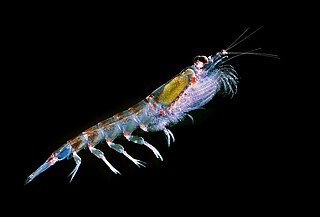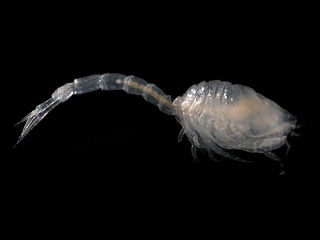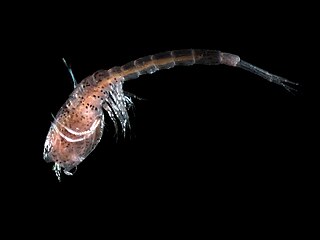Related Research Articles

Mysidae is the largest family of crustaceans in the order Mysida, with over 1000 species in around 170 genera.

Euphausia is the largest genus of krill, and is placed in the family Euphausiidae. There are 31 species known in this genus, including Antarctic krill and ice krill from the Southern Ocean, and North Pacific krill in the Pacific Ocean.

Cumacea is an order of small marine crustaceans of the superorder Peracarida, occasionally called hooded shrimp or comma shrimp. Their unique appearance and uniform body plan makes them easy to distinguish from other crustaceans. They live in soft-bottoms such as mud and sand, mostly in the marine environment. There are more than 1,500 species of cumaceans formally described. The species diversity of Cumacea increases with depth.

Diastylis is a genus of crustaceans which belong to the family Diastylidae. It includes the following species:

Diastylidae is one of the eight most commonly recognised families of crustaceans of the order Cumacea. They are marine creatures especially common around the 30th parallel north.

Bodotriidae is a family of crustaceans belonging to the order Cumacea. Bodotriids have a worldwide distribution in shallow and deep waters. There are over 380 described species in over 30 genera, being the most diverse cumacean family. Their external morphology differs from other cumaceans by a combination of traits that independently are not unique to the family: the telson is fused to the last abdominal segment, the dorsal part of the mandible has a boat shape (naviculoid), exopods exist on the third maxilliped and the first peraeopod, and there is a uropodal endopod with one or two articles.

Leuconidae is a family of marine hooded shrimp. The family was established by Georg Ossian Sars in his 1878 study of Mediterranean cumaceans.

Nannastacidae is a family of crustaceans belonging to the order Cumacea. They have no free telson. The endopods of the uropods are present on one segment. There are exopods on the maxillipeds and generally one on pereopods 1–4 in males and 1–2 in females. In the females the second antenna is much shorter than the first. It contains the following genera:

Bodotria is a genus of crustaceans which belong to the family Bodotriidae. It includes the following species:

Iphinoe is a genus of crustaceans which belong to the family Bodotriidae. It includes the following species:

Petalosarsia is a crustacean genus in the family Pseudocumatidae, comprising three species:
Cyclaspis is a genus of cumacean crustaceans in the subfamily Bodotriinae, containing the following species:

Pseudocuma is a genus of cumaceans, including the following species:

Campylaspis is a genus of crustaceans in the order Cumacea. Species of Campylaspis have a "bulky" carapace, which makes up more than 40% of the animal's length, as well as distinctive features of the mouthparts. There are currently 170 recognised described species:
Mihai Băcescu was a Romanian zoologist.

Eudorella is a genera of marine hooded shrimp in the family Leuconidae. Their skeletons are chitinous.
Dimorphostylis is a genus of crustacean from the Diastylidae family. The scientific name of this species was first published in 1921 by Zimmer.

Cumopsis is a genus of crustaceans in the family Bodotriidae originally described by G.O. Sars in 1878, the type species is Cumopsis goodsir.
References
- ↑ Les Watling (December 21, 2004). Les Watling (ed.). "Nannastacus Bate, 1865". World Cumacea database. World Register of Marine Species . Retrieved February 2, 2010.